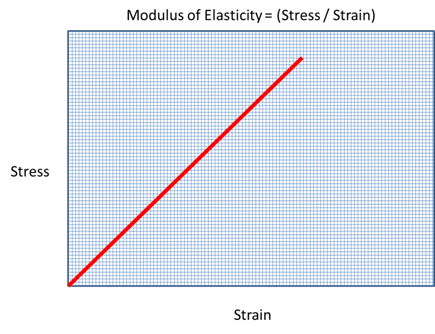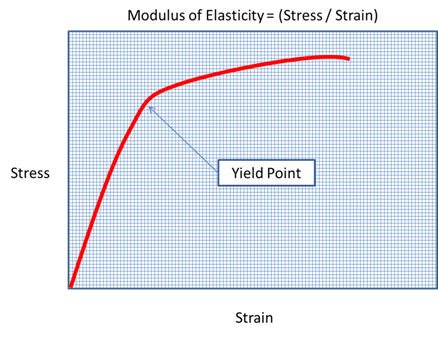Nonlinear Structural Analysis
Material Nonlinearity
When the term "Material Nonlinearity" is used in Structural Analysis, it always refers to the stress-strain characteristics of the material or, how the material responds physically to external forces, or force over a specific area (Stress=Force/Area).
 Perfectly elastic materials are said to have a constant Modulus of Elasticity because they respond in a linear manner to changes in Stress. This is recognized by a constant slope of the material's Stress/Strain curve.
Perfectly elastic materials are said to have a constant Modulus of Elasticity because they respond in a linear manner to changes in Stress. This is recognized by a constant slope of the material's Stress/Strain curve.
A Nonlinear material will have a stress/strain response that varies with the level of stress applied.
 When one thinks of Nonlinear materials, one often thinks about metals and the fact that they begin to permanently stretch after a certain stress level. This is the case for most metals after or near their Yield Strength. There are many other materials that exhibit Nonlinear behaviors as well. Their exact behavior may be influenced by its current deformed state and possibly past history of deformation activity. Other influencing factors may include: pre-stressing, temperature, time, moisture, and electromagnetic fields.
When one thinks of Nonlinear materials, one often thinks about metals and the fact that they begin to permanently stretch after a certain stress level. This is the case for most metals after or near their Yield Strength. There are many other materials that exhibit Nonlinear behaviors as well. Their exact behavior may be influenced by its current deformed state and possibly past history of deformation activity. Other influencing factors may include: pre-stressing, temperature, time, moisture, and electromagnetic fields.
Structure Materials
With respect to Transmission and Distribution Structural Analysis, most common materials used in their construction (e.g. Wood, Concrete, Composite and Steel Poles, H- structures, steel truss towers…) can be assumed to respond in a linear manner to external forces, at the element level. This assumption is used to enable the efficient analysis of the structure, followed by confirmation of this assumption by the Designer. This confirmation can be done by determining each element's maximum stress level and comparing it with the Yield Point for the material used in the element. If a certain material is used in a structure that has some Nonlinear properties, the most common practice would be to use updated element models in the iterative Nonlinear analysis procedure.
Attachment Materials
The Nonlinearity of wire and cable attachment material needs to be considered in order to accurately determine the initial loads applied to the structure. This is done as part of Sags & Tension calculations. These loads may need to be re-calculated as part of Load Nonlinearity.
Foundation Materials
While rock can be considered to be very solid, other types of soil will exhibit plastic behavior if they are excessively loaded past their Yield Point. This Nonlinear, plastic behavior is dependent on the soil's cohesive and non-cohesive properties, plus how much stress is applied to the soil in order to resist movement of the structure. Limiting soil stresses below the Yield Point is the common practice so that these factors can be ignored.
It is also very common for pole line design software to consider the soil as sufficiently rigid for structural calculation purposes, and for designers to remediate weak soil conditions around the structure's foundation so that this assumption can be valid.


